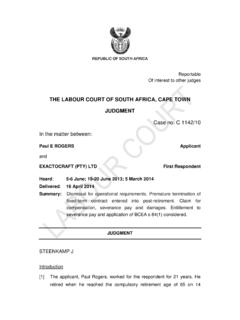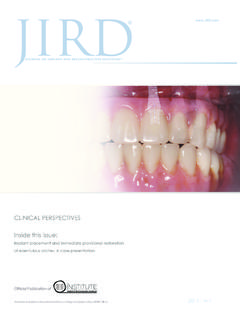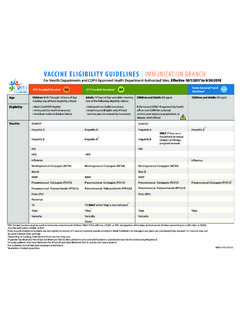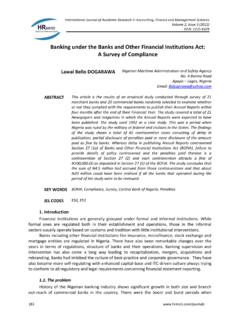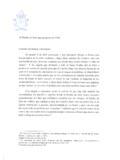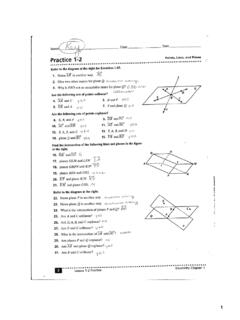Transcription of Feed ingredients and fertilizers for farmed aquatic animals
1 The present technical paper presents an up-to-date overview of the major feed ingredient sources and feed additives commonly used within industrially compounded aquafeeds, including feed ingredient sources commonly used within farm-made aquafeeds, and major fertilizers and manures used in aquaculture for live food production. Information is provided concerning the proximate and essential amino acid composition of common feed ingredient sources, as well as recommended quality criteria and relative nutritional merits and limitations, together with a bibliography of published feeding studies for major feed ingredient sources by cultured species.
2 The main body of the document deals with the nutritional composition and usage of major feed ingredient sources in compound aquafeeds, as well as the use of fertilizers and manures in aquaculture operations. Major feed ingredient and fertilizer groupings discussed include: animal protein sources, plant protein sources, single cell protein sources, lipid sources, other plant ingredients , feed additives, and fertilizers and manures. The concluding section of the document undertakes a comparative analysis of the essential amino acid profiles of the major reported feed ingredient sources for cultured finfish and crustaceans, and presents average reported dietary inclusion levels of major feed ingredient sources used within practical feeds, including their major attributes and limitations.
3 Finally, the importance of feed safety, traceability, and use of good feed manufacturing practices is stressed, together with the importance of considering the long-term sustainability of feed ingredient FAOFISHERIES ANDAQUACULTURETECHNICALPAPERFeed ingredients and fertilizers for farmed aquatic animalsSources and composition 540 FAO feed ingredients and fertilizers for farmed aquatic animals Sources and compositionISSN 2070 -7010 9789251064214I1142E/1 978-92-5-106421-4 ISSN 2070-7010 Cover photographs:Left top to bottom: feed ingredients (groundnut cake, rice bran and maize flour) for preparation of farm-made feed in a carp farm near Thanjavur district, Tamil Nadu, India (courtesy of Vijay Anand).
4 Commonly used feed ingredients for preparation of farm-made aquafeed, Dhaka, Bangladesh (courtesy of FAO/Benoy Barman). Cooked maize used as feed for Chinese mitten crab, Suzhou city, Jiangsu province, China (courtesy of FAO/M. Weimin).Right top to bottom: Harvest of striped catfish (Pangasianodon hypophthalmus) from a pond, Mymensingh, Bangladesh, 2009 (courtesy of FAO/Jayanta Saha). Pellet feed used for feeding of rainbow trout, Forel Farm, Wahdat, Tajikistan, 2009 (courtesy of FAO/Mohammad R. Hasan). feed ingredients and fertilizers for farmed aquatic animalsSources and composition FOOD AND AGRICULTURE ORGANIZATION OF THE UNITED NATIONS Rome, 2009 FAOFISHERIES ANDAquACulTuRETECHNICAlPAPER 540byAlbert Tacon FAO ConsultantHawaii, United States of America Marc Metian Hawaii Institute of Marine BiologyUniversity of HawaiiHawaii, United States of AmericaandMohammad R.
5 Hasan Aquaculture Management and Conservation ServiceFAO Fisheries and Aquaculture DepartmentRome, Italy The designations employed and the presentation of material in this information product do not imply the expression of any opinion whatsoever on the part of the Food and Agriculture Organization of the United Nations (FAO) concerning the legal or development status of any country, territory, city or area or of its authorities, or concerning the delimitation of its frontiers or boundaries. The mention of specific companies or products of manufacturers, whether or not these have been patented, doesnot imply that these have been endorsed or recommended by FAO in preference to others of a similar nature that are not views expressed in this information product are those of the author(s) and do not necessarily reflect the views of 978-92-5-106421-4 All rights reserved.
6 Reproduction and dissemination of material in this information product for educational or other non-commercial purposes are authorized without any prior written permission from the copyright holders provided the source is fully acknowledged. Reproduction of material in this information product for resale or other commercial purposes is prohibited without written permission of the copyright for such permission should be addressed to:Chief Electronic Publishing Policy and Support BranchCommunication Division FAO Viale delle Terme di Caracalla, 00153 Rome, Italy or by e-mail to: FAO 2009iiiPreparation of this documentThis document was prepared as part of the FAO Aquaculture Management and Conservation Service s (FIMA) ongoing regular work programme on Study and analysis of feed and nutrients (including fertilizers ) for sustainable aquaculture development programme entity Monitoring, Management and Conservation of Resources for Aquaculture Development.
7 As part of the FIMA work programme, a targeted workshop on Use of feeds and fertilizers for sustainable aquaculture development was held in Wuxi, Jiangsu Province, China, on 18 21 March 2006. The workshop was organized by FIMA of FAO in collaboration with the Freshwater Fisheries Research Centre (FFRC) of China and the Network of Aquaculture Centres in Asia-Pacific (NACA). The working groups focused on the important role of farm-made aquafeeds in Asia and the need to develop and promote the use of farm-made feeds in sub-Saharan Africa, considered issues pertaining to the production and safe use of aquafeeds and deliberated on the constraints faced by industrial and small-scale aquafeed producers.
8 Several key issues and constraints were identified, categorized and prioritized and appropriate actions were recommended. The workshop recommended FAO to undertake a number of actions to assist regional organizations and member country governments to address a number of identified issues and constraints pertaining to feeds and fertilizers for sustainable aquaculture development from a regional and global perspective. The full report of the workshop has been published in an FAO Fisheries Technical Paper Study and analysis of feeds and fertilizers for sustainable aquaculture development ( ).
9 One of the recommended actions was to compile synopses of the nutritional requirements of major cultured fish species and the feed ingredients currently used in compound/farm-made aquafeeds, including national/regional feed ingredient source books containing information on nutrient composition, quality control criteria, seasonal availability and market price. The present review has been undertaken as part of the above manuscript was reviewed for linguistic quality and FAO house style by Mr Michael Martin. For consistency and conformity, scientific and English common names of fish species were used from FishBase ( ).
10 We acknowledge Ms Tina Farmer and Ms Fran oise Schatto for their assistance in quality control and FAO house style and Mr Jos Luis Castilla Civit for layout design. The publishing and distribution of the document were undertaken by FAO, Rome. Finally, Mr Jiansan Jia, Chief, Aquaculture Management and Conservation Service of the FAO Fisheries and Aquaculture Department, is acknowledged for providing necessary support to initiate the study and to complete the publication. iv AbstractFarmed fish and crustaceans are no different from terrestrial livestock in that their nutritional well-being and health is based on the ingestion and digestion of food containing 40 or so essential dietary nutrients, including specific proteins and amino acids, lipids and fatty acids, carbohydrates and sugars, minerals, vitamins, energy, and water.










